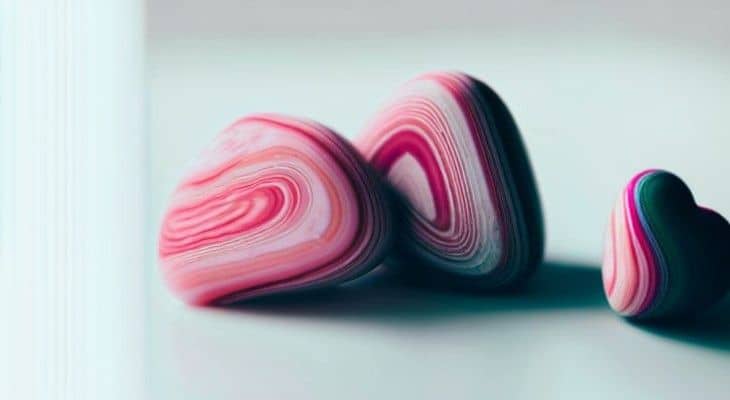Petoskey stones are a unique type of fossilized coral found only in the Great Lakes region. Formed over 350 million years ago during the Devonian period, these ancient fossils showcase a mesmerizing hexagonal pattern – the preserved skeletons of an ancient coral reef. Though they resemble ordinary limestone when dry, their beauty is revealed when wet or polished. It is this distinctive patterning that makes Petoskey stones so special.
As a lapidarist, I am fascinated by the hidden potential in every Petoskey stone I come across. Though drab and unremarkable at first glance, they transform into works of art when expertly cut and polished. The contours of each stone guide my work, as I carefully shape, grind, and buff them to draw out their inner radiance. It is an honor to unlock the beauty of these ancient fossils through the art of lapidary.
When complete, every hand-polished Petoskey stone becomes a unique work of art. The patient hours invested in the lapidary process allow their exquisite patterning to shine through. No two stones are exactly alike – each one has its own story etched into those hexagonal halls over the eons. From jewelry to bookends and beyond, the creative possibilities are endless. As a lapidarist, it is my passion to reveal the singular majesty hidden within every Petoskey stone.
Overview
Petoskey stones are a type of fossilized coral that can be found along the shores of Lake Michigan, primarily in the state of Michigan. They are named after the town of Petoskey, located in northwest Michigan, and are the state stone of Michigan. Petoskey stones have a unique appearance, characterized by their distinct hexagonal patterns, which are the result of the fossilized skeletal remains of colonial coral species.
The origin of Petoskey stones dates back to over 350 million years ago, during the Devonian period, when the area that is now Michigan was covered by a warm, shallow sea. The coral lived in this sea and over time, their skeletons accumulated and became fossilized. Later, geological forces uplifted the area and the fossils were exposed, becoming the Petoskey stones we know today.
In terms of physical properties, Petoskey stones are relatively soft compared to other types of rocks, with a hardness rating of around 4 on the Mohs scale. They are usually light in weight, and can range in color from light gray to light brown. Their unique patterning is what makes them most special, and it is this that makes them highly prized among rock collectors and lapidarists.
There are some restrictions on collecting Petoskey stones in certain areas, such as state parks, where collecting of any type of rock or mineral is prohibited. It is important to be aware of local regulations and to only collect Petoskey stones from areas where it is allowed.
Petoskey stones can be found along the shores of Lake Michigan, primarily in the state of Michigan. The best time to search for Petoskey stones is after a storm or after the lake has been rough, as this helps to expose new stones. They can also be purchased from rock and mineral shops, or from online retailers. Whether found in the wild or purchased, Petoskey stones are a beautiful and unique type of rock that are sure to be treasured for generations to come.
Comparison
Petoskey stones have a unique appearance that sets them apart from other rocks, stones, and minerals. However, there are several other materials that may be mistaken for Petoskey stones due to their similar appearance or location. Here is a list of some of these materials, along with a description of how to differentiate them from Petoskey stones:
- Fossilized coral: Fossilized coral can closely resemble Petoskey stones, but unlike Petoskey stones, it does not have the hexagonal patterning. Fossilized coral can be differentiated from Petoskey stones by its lack of patterning and its more porous, less dense appearance.
- Limestone: Limestone is a common sedimentary rock that can be found in many areas where Petoskey stones are found. Limestone can be differentiated from Petoskey stones by its uniform color and lack of patterning, as well as its heavier weight and higher density.
- Chert: Chert is a type of sedimentary rock that is similar in appearance to flint or quartz. Chert can be differentiated from Petoskey stones by its smooth, glass-like texture and lack of patterning.
- Dolomite: Dolomite is a type of sedimentary rock that can closely resemble limestone. Dolomite can be differentiated from Petoskey stones by its slightly pinkish-brown color and lack of patterning.
- Flint: Flint is a type of sedimentary rock that is similar in appearance to chert. Flint can be differentiated from Petoskey stones by its slightly rough texture and lack of patterning.
| Material | Characteristics | How to differentiate from Petoskey Stones |
|---|---|---|
| Fossilized coral | No hexagonal patterning, porous, less dense | Lack of patterning |
| Limestone | Uniform color, lack of patterning, heavy weight, high density | Lack of patterning |
| Chert | Smooth, glass-like texture, lack of patterning | Texture, lack of patterning |
| Dolomite | Pinkish-brown color, lack of patterning | Color, lack of patterning |
| Flint | Slightly rough texture, lack of patterning | Texture, lack of patterning |
It is important to be familiar with the characteristics of these materials in order to accurately differentiate them from Petoskey stones. By understanding the unique features of each material, you can better appreciate the beauty and uniqueness of Petoskey stones and other types of rocks, stones, and minerals.
Polishing Petoskey stones using NATIONAL GEOGRAPHIC Rock Tumbler
Polishing Petoskey stones using a rock tumbler is a fun and relatively easy process similar to polishing agate. Here are the steps to follow:
- Gather materials
You will need a rock tumbler, grits (coarse, medium, and fine), water, and Petoskey stones.
- Clean the stones
Rinse the Petoskey stones with water to remove any dirt or debris.
- Fill the tumbler
Add water to the tumbler to the recommended level and add the coarse grit. Then add the Petoskey stones.
- Run the tumbler
Turn on the tumbler and let it run for several hours, usually overnight, until the stones are well rounded and smooth.
- Change the grit
Once the stones are well rounded, drain the water and add fresh water. Then add the medium grit and repeat the tumbling process for several more hours.
- Change the grit again
Once the stones are smooth, drain the water and add fresh water. Then add the fine grit and repeat the tumbling process for several more hours, until the stones have a high-gloss shine.
- Dry the stones
Once the tumbling process is complete, remove the stones from the tumbler and place them on a clean towel to air dry.
- Final inspection
Inspect the stones to make sure they are free of any grit or debris, and that they have a nice, polished finish.
Cleaning Petoskey Stones: The Vinegar Soak Method
After we’ve covered the origin, characteristics, and polishing techniques of the unique Petoskey stones, let’s dive into an often-overlooked but extremely vital topic: cleaning the stones. To truly appreciate the beauty of your Petoskey stones and maintain them in their best condition, a proper cleaning method is necessary. Here, I will introduce a popular method used by rock hunters – soaking Petoskey stones in vinegar.
You can place this text under the section ‘Polishing Petoskey stones using NATIONAL GEOGRAPHIC Rock Tumbler’ as a new H2 titled ‘Cleaning Petoskey Stones: The Vinegar Soak Method.’ This section will add value by providing important information about cleaning the stones before the polishing process.
Gathering Your Cleaning Tools
The first step is to gather all the tools necessary for this task. Below is a list of items that you’ll need:
| Tools Required | Description |
|---|---|
| Petoskey Stones | These are the fossils you’re going to clean. |
| White Distilled Vinegar | It helps to dissolve the sediment and calcite on the stones. |
| A Soaking Container | This will hold the stones and vinegar. |
| A Brush | This is for brushing off any excess sediment after soaking. |
The Vinegar Soak Method
- The Pre-soak Inspection: Start by taking a good look at your Petoskey stones. The beauty of each stone is unique, much like a picture. While inspecting them, you might notice tiny bits of sediment trapped in the stones’ hexagonal patterns. This is what the vinegar will help remove.
- Prepare the Soak: Place the stones in your chosen container and fill it with white distilled vinegar until all stones are fully covered. The vinegar is the star of this cleaning method because it will dissolve the calcite that’s holding the sediment, making it easier to clean the stones.
- Soak the Stones: Let the stones soak in vinegar for about 16 to 50 hours. You might wonder why this time range? It’s because the exact timing can depend on the amount of sediment on your stones. During the soaking period, you can see a little bit of science magic happening right before your eyes as the vinegar interacts with the stones.
- Post-soak Cleaning: Once the soak time is up, take the stones out of the vinegar. You should see a noticeable difference. With a brush, gently scrub the stones under running water to remove any loosened sediment.
- Inspect and Repeat (if necessary): Inspect your stones after cleaning. If you still notice some sediment, you might need to repeat the soaking and cleaning process. But don’t worry, it’s worth the extra effort to make these ancient fossils shine!
After you’ve cleaned your Petoskey stones using this method, they are ready to be tumbled and polished, as described in the earlier section. You can find many “before and after” videos of this process on YouTube. Seeing the transformation from a stone covered in sediment to a beautiful polished fossil is truly a sight to behold.
Note: Some people may wonder, “Why vinegar?” White distilled vinegar is acidic, which is why it’s so effective at dissolving calcite. But remember, only use it for cleaning the stones, not for soaking them for an extended period as it could dissolve the entire fossil.
Thank you for joining me on this exploration of the fascinating world of Petoskey stones. Happy hunting and cleaning!
Cleaning Your Petoskey Fossils
One of the easiest ways to clean marine fossils like Petoskey stones found on the beach is with vinegar.
To clean your Petoskey fossil specimen:
- Pour 2 cups of white vinegar into a bowl and place your fossil inside. The acetic acid in the vinegar will react with the calcium carbonate in the fossil in a chemical reaction that dissolves and loosens debris.
- Let the fossil soak for 10-20 minutes. Check it periodically and use a toothbrush to gently rub any dirty spots.
- After soaking, remove the fossil from the vinegar and rinse it under running water for two minutes. Use the toothbrush to scrub away any remaining debris.
- Repeat steps 1-3 as needed until you are happy with the cleanliness of your fossil. If there are any stubborn spots try letting it soak for longer.
The vinegar soak helps remove sediment and chemicals like calcium carbonate that may be obscuring the details of the fossil inside. Be careful not to over-soak the specimen in vinegar as it can damage the fossil if left too long.
With a little time and effort, you can safely clean your Petoskey stone without harming the ancient fossil it contains!
Tips
Caring for Petoskey stones is an important part of preserving their beauty and ensuring that they last for many years. Here are some tips for caring for your Petoskey stones:
- Clean regularly: Clean your Petoskey stones regularly with a soft cloth or brush to remove any dirt or debris.
- Store properly: Store your Petoskey stones in a safe, dry place away from direct sunlight and moisture, which can cause discoloration and damage.
- Handle with care: Petoskey stones are delicate and can break or chip easily, so handle them with care and avoid dropping them.
- Avoid harsh chemicals: Avoid exposing Petoskey stones to harsh chemicals, such as bleach or vinegar, as these can cause damage and discoloration.
- Use a protective coating: Apply a protective coating, such as wax or oil, to your Petoskey stones to help protect them from scratches and damage.
- Avoid heat: Avoid exposing Petoskey stones to high temperatures, as this can cause damage and discoloration.
- Keep dry: Avoid getting your Petoskey stones wet, as moisture can cause damage and discoloration.
- Be careful with jewelry: If you use Petoskey stones in jewelry, be sure to avoid exposing them to harsh chemicals, such as perfume or hair spray, and avoid wearing them in water.
By following these tips, you can help protect your Petoskey stones and ensure that they maintain their beauty and shine for many years to come.
FAQ
Frequently Asked Questions About Petoskey Stones:
What is a Petoskey stone?
Where can Petoskey stones be found?
How old are Petoskey stones?
How are Petoskey stones formed?
Are Petoskey stones rare?
What are Petoskey stones used for?
How do I care for my Petoskey stones?
Can Petoskey stones be polished?
Conclusions
In conclusion, Petoskey stones are truly a remarkable and unique treasure from the ancient seas of the Great Lakes region. From their fossilized hexagonal pattern to their beautiful and distinctive appearance, Petoskey stones have captured the hearts of many for generations. Whether used for jewelry, decorative objects, or simply admired as collector’s items, Petoskey stones are sure to bring a touch of beauty and rarity to any collection. With proper care and handling, these beautiful fossils can be enjoyed for many years to come. So why not start your own collection of Petoskey stones today and discover for yourself the magic and wonder of these ancient treasures!




Hi John, do you have an email to reach out?
Hi, Jane.
Write me [email protected]